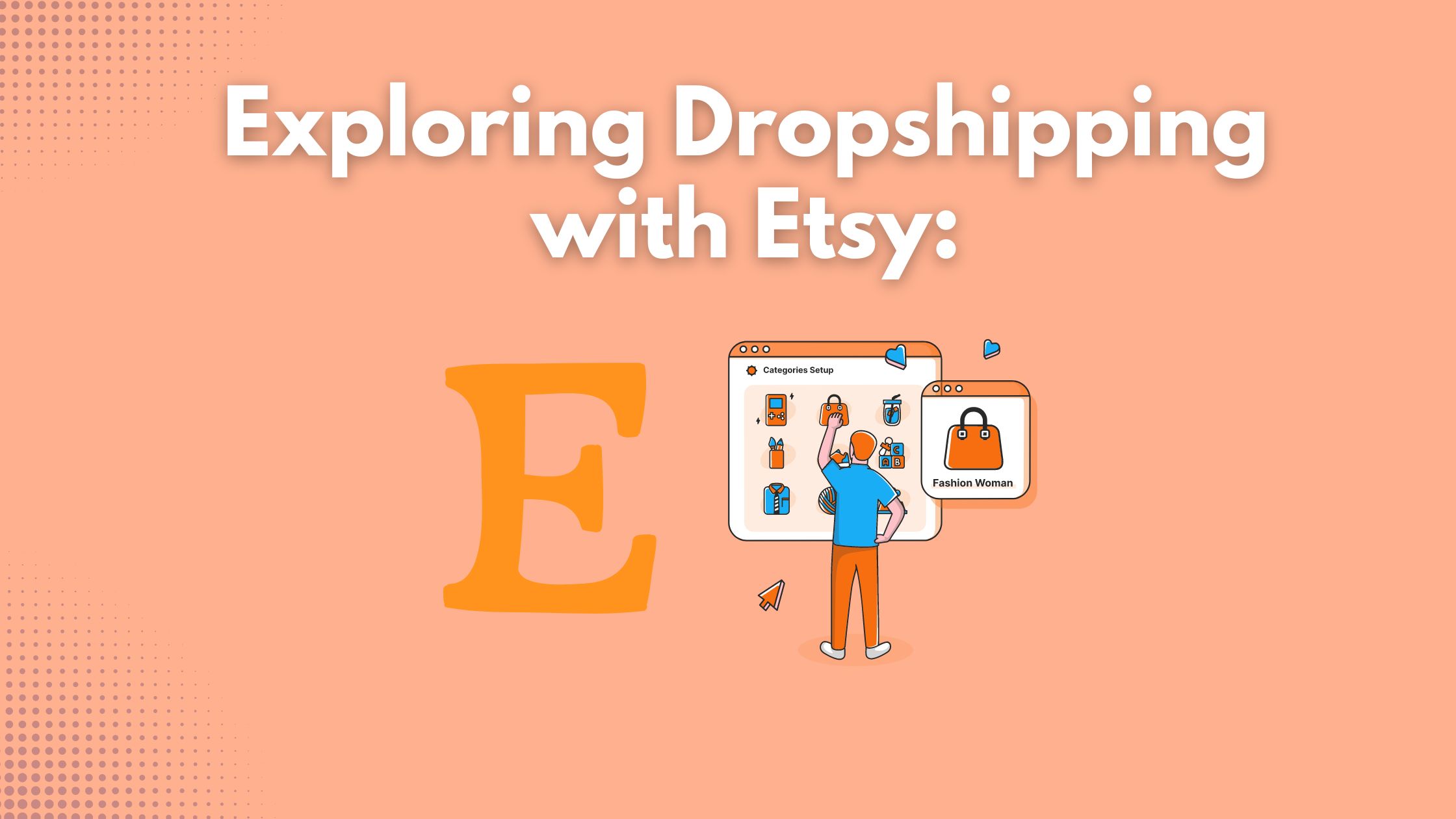Exploring Dropshipping with Etsy: The Simple Guide
Picture this: you’re chilling on your couch, scrolling through a delightful array of unique, artisanal items on Etsy. Suddenly, you spot an antique brass necklace that speaks to your soul, and in a matter of clicks, it’s yours. That, my friend, is the magic of ecommerce.
But let’s sprinkle in a little more magic – imagine running a shop on Etsy, selling products you never have to store, pack, or ship.
Welcome to the world of dropshipping. Intrigued? Buckle up because we’re about to deep-dive into dropshipping on Etsy and why it might be the next big thing in your ecommerce journey.
Etsy, the vibrant online marketplace known for its unique, handmade, and vintage items, is more than just a hobbyist’s paradise.
It’s a thriving ecosystem offering opportunities for crafters, artists, and now, dropshippers. The global phenomenon that is Etsy has breathed life into countless small businesses worldwide, making it a key player in the ecommerce universe.
But what happens when you combine the potency of dropshipping with the unique appeal of Etsy? You get an exciting ecommerce model that just might be the pathway to your entrepreneurial dreams.
So, join us as we navigate the ins and outs of dropshipping on Etsy, exploring its potential, challenges, and perhaps, its undeniable allure.
Understanding Dropshipping and Etsy
Before we plunge into the intricacies of marrying dropshipping and Etsy, let’s quickly put some faces to these names, shall we?
Dropshipping – If we had to choose a “business model of the year” award, dropshipping might just snag the trophy. Essentially, it’s a retail method where the seller doesn’t keep products in stock. Instead, when a customer places an order, the seller purchases the item from a third party and has it shipped directly to the customer. This means you, as a seller, never have to get your hands dirty (literally) with packing or shipping. The beauty of dropshipping lies in its simplicity and low risk: No inventory? No problem!
Etsy – Picture a bustling, colorful marketplace, buzzing with artists, crafters, vintage collectors, and millions of customers seeking unique, authentic items. Now, translate that into the digital world. Congratulations, you’ve just visualized Etsy! Founded in 2005, Etsy has positioned itself as the go-to platform for handmade, vintage, and craft supply items. Its user base is vast and diverse, offering a treasure trove of opportunities for sellers to find their niche.
Dropshipping and Etsy might seem like two entirely different worlds, but they are more connected than you might think. Imagine leveraging the low-risk model of dropshipping in a marketplace teeming with eager customers looking for unique items. Sounds promising, right? Well, buckle up, because we’re about to unravel the potential of dropshipping on Etsy.
Can You Use Dropshipping on Etsy?
Now, to the burning question you’ve probably been itching to ask: Can you actually use dropshipping on Etsy?
Yes, you can! But, as with all good things in life, there are some important rules to follow.
You see, Etsy is passionate about preserving its reputation as a platform for unique and authentic goods. So, they have specific policies around dropshipping. Let’s take a quick tour through Etsy’s rulebook:
- Reselling is a no-go: You can’t purchase products from another retail store and simply resell them on Etsy. So, if you had plans to buy off-the-shelf items in bulk and list them as your own, you might want to reconsider.
- Third-party help is okay: You’re allowed to use a third-party to help with fulfillment. This is where dropshipping comes in. As long as you’re transparent about it (more on that soon), you can partner with a supplier to ship products directly to your customers.
- Design and creation are key: If you’re using a production partner (like a dropshipper), you must play a substantial role in designing your products. In short, it’s essential to maintain the ‘handmade’ spirit Etsy is loved for.
So, dropshipping on Etsy is like a challenging game – it requires strategy and adherence to the rules. But with the right approach, it can be a powerful tool to expand your online business.
The Pros and Cons of Dropshipping on Etsy
Just like a see-saw, every business decision has its ups and downs, and dropshipping on Etsy is no exception. So, let’s grab a virtual magnifying glass and examine the pros and cons.
The Upside: The Pros of Dropshipping on Etsy
- Niche Businesses Are Welcomed: Etsy is like a treasure trove of unique, niche items. It’s a hub for the quirky, the handcrafted, the vintage. If you’ve got a product that fits a particular niche, Etsy is the place for it. Remember, people come to Etsy looking for something different, something they won’t find on the shelves of their local supermarket.
- Low Competition: Compared to eCommerce giants like Amazon, Etsy has less competition for dropshippers. The smaller pool of competitors could be the game-changer for your store.
- Established Customer Base: Etsy already has a loyal customer base that values quality, handmade, and unique items. If your products align with these values, you’re already off to a great start!
The Downside: The Cons of Dropshipping on Etsy
- High Fees: Selling on Etsy comes with its costs. There’s a listing fee, a transaction fee, and a payment processing fee. If you’re not careful, these can eat into your profits.
- Rigid Rules: Etsy’s rules are strict when it comes to preserving its “handmade” ethos. You must ensure you’re complying with their policies or face potential suspension.
- Scalability Issues: While Etsy is great for small, niche businesses, it can be challenging to scale your business due to the platform’s focus on handcrafted and unique products.
Remember, it’s all about balance. With the right strategies, you can leverage the benefits of dropshipping on Etsy while mitigating the downsides.
Etsy Dropshipping in Practice: How to Get Started
So, you’ve weighed the pros and cons and decided to dive into the world of Etsy dropshipping. That’s fantastic! Let’s make sure you’re armed with the knowledge needed to set the wheels in motion.
Step 1: Understand Etsy’s Policies
Before you take the plunge, it’s crucial to thoroughly understand Etsy’s policies. As a platform renowned for handmade and vintage items, Etsy maintains strict guidelines around what can and cannot be sold. In terms of dropshipping, Etsy allows it, but the products must be handmade or designed by you.
Step 2: Find a Supplier
The next step is to find a reliable supplier who offers products that align with your business vision and Etsy’s guidelines. Remember, reliability is key. Your supplier should have a proven track record of timely and accurate deliveries, high-quality products, and excellent customer service.
Step 3: Set Up Your Etsy Shop
Once you’ve selected your products and secured a reliable supplier, it’s time to set up your Etsy shop. You’ll need to choose a unique name, upload a logo, write a compelling shop description, and outline your shop policies.
Step 4: List Your Products
Now, let the world see your curated collection! Write compelling product descriptions, take high-quality product photos, and set competitive prices. Be sure to disclose in the product listing that you are the designer and someone else makes the item on your behalf.
Step 5: Market Your Shop
Once your shop is live, it’s time to draw customers in. Use SEO best practices to make your products discoverable on Etsy. Additionally, leverage social media platforms, email marketing, and influencer partnerships to increase your shop’s visibility.
Step 6: Manage Your Orders
Now that orders are coming in, your primary responsibility is to ensure your supplier fulfills them promptly and accurately. Customer satisfaction is paramount in dropshipping.
Step 7: Analyze and Adjust
Finally, keep track of your performance. Which products are selling well? Where is most of your traffic coming from? Use this information to tweak your strategy, optimize your shop, and grow your business.
And voila! You’ve embarked on your Etsy dropshipping journey.
Strategies for Etsy Dropshipping
Now that you’re on your way to starting your dropshipping journey on Etsy, let’s take a look at some of the most popular strategies that successful Etsy dropshippers use.
Dropshipping from AliExpress to Etsy
AliExpress is a massive online retail marketplace based in China that offers a wide array of products at wholesale prices, making it a popular choice for dropshippers worldwide.
To dropship from AliExpress to Etsy, you’ll first need to find a supplier on AliExpress that offers products that meet Etsy’s criteria for handmade or vintage items. After choosing your products and setting up your Etsy shop, list the products on your Etsy store. Whenever a customer makes a purchase, you’ll then order the item from AliExpress, providing your customer’s shipping details.
Remember to maintain good communication with your customers about delivery times since shipping from China can often take longer.
Dropshipping from Amazon to Etsy
Amazon-to-Etsy dropshipping operates similarly. Amazon is a vast marketplace that offers countless product options. However, not all items on Amazon meet Etsy’s strict guidelines. Be diligent in selecting products that fall within the boundaries of Etsy’s rules.
Once you find suitable products and suppliers on Amazon, the process is the same. List the products on Etsy, and when a customer places an order, purchase the item from Amazon and have it shipped directly to your customer.
Etsy to Shopify: A Dropshipping Guide
Shopify is a popular ecommerce platform that allows you to create an online store, making it a great platform to expand to from Etsy.
To dropship from Etsy to Shopify, you’ll need to find Etsy sellers who allow reselling of their handmade products. Then, list these items on your Shopify store. When a customer places an order on your Shopify store, you order the item from the Etsy seller and have it shipped directly to your customer.
Always remember to respect and follow the rules of each platform to maintain a good standing and promote a healthy ecommerce ecosystem.
Understanding Etsy’s Fees and Rules for Dropshipping
Navigating any ecommerce platform’s fees and rules can feel like you’ve stepped into a labyrinth, but don’t worry, we’re here to guide you through Etsy’s unique landscape.
Etsy’s Fee Structure
If you’re contemplating dropshipping on Etsy, it’s crucial to understand the platform’s fee structure. Here’s a quick breakdown:
- Listing Fees: Etsy charges $0.20 for each item you list in your shop. Note that the listing will remain active for four months or until the product is sold out.
- Transaction Fees: Once you make a sale, Etsy takes a 5% transaction fee on the sale price, including the shipping price you’ve set.
- Payment Processing Fees: If you use Etsy Payments, their in-house payment processing system, there are additional fees. These fees vary based on the location of your bank.
Be sure to factor these fees into your pricing strategy to ensure profitability.
Understanding Etsy’s Dropshipping Rules
Just as crucial as understanding the fees is understanding the rules, especially around dropshipping. Etsy’s rules can be a little stringent compared to other platforms, primarily due to its focus on handmade and vintage items.
Here are the key points to remember:
- Handmade Items: According to Etsy’s rules, handmade items should be made or designed by you. If you’re partnering with another artist or a company to produce your designs, you must disclose this in your listings.
- Vintage Items: To qualify as vintage, items must be at least 20 years old.
- Craft Supplies: Etsy allows craft supplies, including tools, ingredients, and materials, to be sold on the platform.
- Reselling: Reselling is not allowed on Etsy unless the items fall into the craft supplies or vintage categories.
When dropshipping on Etsy, ensure that you’re transparent with your customers about where your items are coming from and how they’re made. Always keep in mind that trust and transparency are key to maintaining a successful Etsy shop.
Navigating Competition and Finding Your Niche on Etsy
In the vast cosmos of the ecommerce universe, Etsy stands as a shining star for niche businesses. But why is this so, and how can you effectively stand out among the competition?
Etsy: A Haven for Niche Businesses
Unlike some other ecommerce platforms, Etsy is not a battleground of mass-produced goods competing on the lowest price. Instead, it is a vibrant marketplace celebrating the unique, the handmade, and the vintage. If you have a product that fits into a specific niche or category, there’s a good chance that there’s an audience on Etsy who is looking for exactly what you’re offering.
Additionally, Etsy’s customers are often willing to pay a premium for these unique items, providing an opportunity for better profit margins. This makes Etsy an especially attractive platform for niche businesses.
Standing Out Amid the Competition
Even though competition on Etsy is lower compared to other ecommerce giants, it doesn’t mean you won’t face any. So, how can you make your shop stand out?
- Master SEO: Understand Etsy’s SEO practices to ensure your listings appear in customer searches. Use relevant keywords in your listing titles, descriptions, and tags.
- Quality Over Quantity: Ensure your products are high-quality. With Etsy’s focus on unique and handmade items, quality is a key differentiator.
- Leverage Social Proof: Encourage satisfied customers to leave reviews. Positive reviews not only enhance your shop’s credibility but also improve your visibility on Etsy.
- Exceptional Customer Service: Provide excellent customer service to build a loyal customer base. Respond promptly to queries, resolve issues effectively, and ensure quick and reliable delivery.
- Tell Your Story: Etsy buyers love to know the story behind the products and the seller. Sharing your journey can help to build a strong emotional connection with your customers.
Remember, success on Etsy isn’t just about selling a product; it’s about creating an experience. Stand out by focusing on what makes your shop unique, and you’ll find your own constellation of customers ready to engage.
Scaling Your Etsy Dropshipping Business
Scaling any business is a challenge, and dropshipping on Etsy is no exception. While Etsy offers a unique platform for niche businesses, its particular model also brings specific considerations when it comes to growth.
Challenges and Solutions for Scaling
The first challenge that many Etsy sellers face when scaling is the platform’s emphasis on handmade and unique items. If you are dropshipping, you may not be making the products yourself, making it harder to comply with Etsy’s policies while scaling.
One solution is to focus on sourcing unique and quality items that fit Etsy’s customer base. This means carefully selecting suppliers who produce handmade items or provide vintage or unique products. It may require more effort than simply choosing mass-produced items, but it can help you maintain the ethos of the platform while expanding your operations.
Another common challenge is the cost. Etsy’s fees, including listing and transaction fees, can add up, especially when you’re looking to increase the number of items in your store.
A strategic way to navigate this is by focusing on improving your profit margins. This could be done by optimizing your pricing strategy, offering premium products, or minimizing shipping costs by choosing suppliers strategically.
Effective Listing to Boost Sales
Effectively listing your products on Etsy is crucial to driving sales and can help you scale your business. Here are a few tips:
- Use SEO: Make sure to use keywords that potential customers may be searching for in your titles, descriptions, and tags.
- Quality Images: Use clear, high-quality images that accurately represent your product. Remember, online customers can’t touch or feel the product, so your images should tell a compelling story.
- Detailed Descriptions: Your descriptions should not only include product specifications but also the story behind the product, making it more attractive to Etsy customers.
- Pricing Strategy: Price your items strategically. Ensure they reflect the value of the product but also keep in mind the pricing norms within your niche.
- Reviews: Encourage customer reviews. They can greatly influence a potential buyer’s decision.
Scaling your Etsy dropshipping business involves strategic planning and smart decision-making. It might be a challenging journey, but with the right moves, it can also be a rewarding one.
Alternatives to Etsy for Dropshipping
While Etsy is a unique platform that holds ample opportunity for niche businesses, there are numerous other avenues for those looking to venture into dropshipping. Here’s a brief overview of some alternative platforms to consider:
Wholesale2B
Wholesale2B is a dedicated dropshipping platform, offering a wealth of resources for businesses. With over one million products from verified suppliers and an automated ordering system, Wholesale2B simplifies the dropshipping process. It integrates with various sales channels, including Amazon, eBay, and Shopify, giving you the flexibility to sell on multiple platforms.
Shopify
Shopify is one of the most popular ecommerce platforms and for good reason. It offers a robust, user-friendly system for building your online store and managing your inventory. The platform also integrates with numerous dropshipping apps such as Oberlo, Spocket, and Modalyst, simplifying the process of product sourcing. With its extensive customization options and marketing tools, Shopify can provide a comprehensive solution for your dropshipping needs.
eBay
eBay, one of the pioneers of ecommerce, can also be a viable platform for dropshipping. While it’s traditionally known as an auction site, it has evolved into a marketplace for new, used, and unique items. eBay’s vast global audience can be an advantage for dropshippers seeking to reach a wide range of customers.
Amazon
Amazon’s dropshipping policy allows sellers to fulfill orders directly from suppliers. This makes it another potentially lucrative platform for your dropshipping business. While it may be more competitive due to the sheer volume of sellers, the vast customer base and trusted reputation make Amazon an option worth considering.
Each platform has its advantages and disadvantages. Therefore, when considering an alternative to Etsy for dropshipping, it’s important to align your choice with your business model, your target audience, and your unique selling propositions.
Conclusion
Well, there you have it, folks – your crash course into the intriguing world of Etsy dropshipping. Before we bid adieu, let’s quickly recap the key points we’ve covered:
- Understanding Dropshipping and Etsy: Dropshipping is a business model where you sell products that are stored and shipped by a third-party supplier. Etsy is an online marketplace known for unique, handmade, and vintage items.
- Can You Use Dropshipping on Etsy?: Yes, you can, although there are certain guidelines you need to follow to stay within Etsy’s policies.
- The Pros and Cons of Dropshipping on Etsy: While Etsy welcomes niche businesses and offers comparatively low competition, it also has its downsides such as high fees and rigid rules.
- Etsy Dropshipping in Practice: Setting up a dropshipping operation on Etsy involves selecting products, setting up a shop, listing items, and managing orders.
- Strategies for Etsy Dropshipping: You can dropship from platforms like AliExpress and Amazon to Etsy, or from Etsy to Shopify.
- Understanding Etsy’s Fees and Rules: Etsy charges a listing fee, a transaction fee, and a payment processing fee, among others. Ensure you understand these costs and Etsy’s rules around dropshipping.
- Navigating Competition and Finding Your Niche: With its focus on unique items, Etsy can be a great platform for niche businesses.
- Scaling Your Etsy Dropshipping Business: The key to scaling is to constantly optimize your product listings, customer service, and marketing strategies.
- Alternatives to Etsy for Dropshipping: Other platforms like Wholesale2B, Shopify, eBay, and Amazon can also serve as effective platforms for dropshipping.
Starting your own Etsy dropshipping business can be an exhilarating experience. Sure, there might be a few hiccups along the way, but remember, even the smoothest seas never made skilled sailors. So don’t be afraid to dive in, test the waters, and take the plunge into the world of Etsy dropshipping. Your ecommerce journey awaits!
The Future of Ecommerce: Year Over Year Growth and Predictions for Continual Expansion
The Future of Ecommerce: Year Over Year Growth and Predictions for Continual Expansion What is the...
A Comprehensive Guide to Prebuilt Dropshipping Stores (2023 Edition)
A Comprehensive Guide to Prebuilt Dropshipping Stores (2023 Edition)Ever dreamt of stepping into...
How Much Can You Make With An Ecommerce Store? Tips And Tricks
How Much Can You Make With An Ecommerce Store? Tips And TricksEcommerce has revolutionized the way...







